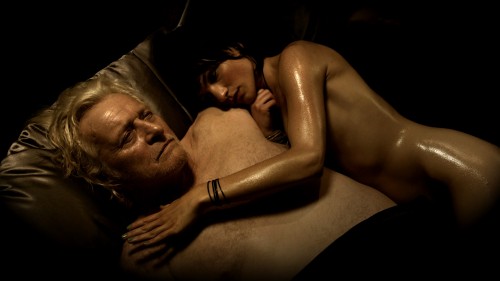Written by: Belle McIntyre

Il Futuro, starring Rutger Hauer and Manuela Martelli, based on a novel by the Chilean,
Roberto Bolano, is a subtle exploration of damaged souls who come together for
practical reasons but discover the humanity in each other and a certain degree of hope.
That is the story at the heart of this film. The larger story is one of two orphans living in
Rome.
The film opens as two teenage siblings in a police station in Rome are being given the
belongings of their parents who have just been killed in a car crash. There is a social
worker who offers bland words of encouragement to the two shell-shocked orphans.
When she suggests that the younger brother, Tomas, could go to an orphanage,
nineteen year old Bianca, refuses and agrees accepts the responsibility to take care of
him and see that he goes to school. They still have their parents apartment and they
will get a small income from their father’s pension. Bianca quits school and gets a job in
a beauty shop to make up the difference.
Bianca as played by Martelli reminded me of Rooney Mara in the Stig Larson films. She
has a severe intensity but reveals very little and appears to be living in her own totally
isolated world. She hardly speaks to anyone unless it is necessary. In constrast, Tomas,
seems fairly resilient and behaves like a fairly average irresponsible teenager who has
no parental restraints
Since they still need more money to get by on, a couple of unsavory characters who
have befriended Tomas, hatch a plan for all of them to get some easy money. They tell
of the legendary Maciste, a former Mr. Universe, who went on to make a lot of
Hollywood films - costume dramas of the toga and sandals ilk. He is now blind and lives
reclusively in a crumbling mansion. It is this which puts a reluctant Bianca in the world of
Maciste - a world so far apart from the one she is living.
The mansion is gloomy, cold and dark with most of the funiture under sheets. It suits
her perfectly because since the accident she has developed a hyper-sensitivity to light,
which gives her severe headaches. Maciste is a man of few words, understandably
embittered but he is gentle with her, and patient. She has felt untethered since the
accident and is still numb enough to be able to adjust to this new strange situation. They
are actually a good match and over time they begin to trust each other and a genuine
affection develops between them and she refuses to take advantage of him.
The incident which breaks the spell between Bianca and Maciste and Tomas and his
friends signals a new beginning for the siblings. They have each managed their loss in
completely different ways without ever directly dealing with it. They have gone into a
dark place and come out into the light. And suddenly the film ends. It feels abrupt.
But the heart of the story between Bianca and Maciste is the reason for seeing this film.
The cinematography is moody and atmospheric with the camera lingering over beautiful
surfaces and architectural elements and Bianca’s mostly naked body with chiaroscuro
lighting. It is very touching to see the two of them tentatively open themselves up to
each other and tragic when the door closes.




